Q&A – Ask Neil: December 8, 2022
(Please read these instructions carefully.)
Before you post your question, please look at recent issues to see if someone else has already asked it. You might find your answer there.
November 24, 2022 Q&A part one
November 24, 2022 Q&A part two
How to submit your question…
• Click the link provided below to post your question. After you submit your question, a new window will pop up giving you the address to which you can e-mail a photo to accompany your question. Clear, medium-resolution photos. (Try to avoid low-res thumbnail photos, please, in case I have to zoom in to see things.)
• Click here to post your question.
• Please only post your question one time.
• One question per reader, please.
• Please use this only for posting questions – not for standard emails.
• Watch for your answer in the following week’s e-gardens.
• I choose those of greatest general interest. For example, plant IDs seldom make the cut.
• I must have your first name or initials.
• I must have your city or county. (Texas is a very large state.)
QUESTION 1
POST OAK BROKE EXPOSING FUNGUS. CAN I STOP IT FROM SPREADING?
Question: We have a large post oak that had three trunks. Last month’s rain seems to have caused one of the trunks to fail, exposing a band of white fungus. What can I use to stop the spread of the fungus? Can I smooth the break and coat it? Jay M., Pilot Point.
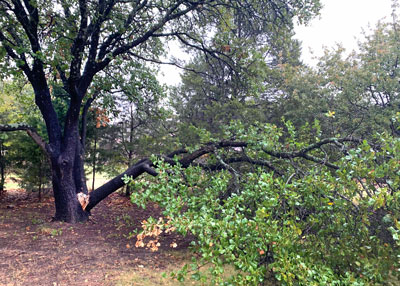
Answer: If you can possibly get a certified arborist, Texas A&M Forest Service forester or Texas AgriLife plant pathologist to look at this tree close-up, collect tissue samples and determine what the fungal organism is you’ll have a better idea of how to proceed. This didn’t happen just because of one rainstorm. The wood in that branch has been compromised for some time and I would imagine that the remaining trunk is also involved. It looks like even if you lost that second trunk, the rest of the tree may have fairly good form. This is going to involve much more than simply spraying a fungicide onto the wound or spraying it with pruning sealant. It really needs to start with a professional looking at it close up to check the soundness of the surviving trunk.
QUESTION 2
HOW TO DISCOURAGE SQUIRRELS FROM CHEWING BARK OF JAPANESE MAPLES.
Question: I read your story on Japanese maples and I’m wondering how I can keep squirrels from eating their bark. I had two in my backyard for quite a while, but both were killed by squirrels before I could figure out what was causing the problem. Mike M., Arlington.
Answer: Squirrels’ teeth keep growing continuously, so they are forced to sharpen them every day much as we clip or file our nails periodically. You don’t want to do anything to harm them, but something that might discourage them would be helpful. If it comes to it, consider the ultra-sticky Tree Tanglefoot or some similar product applied to the trunk or branches in their climbing zones.
QUESTION 3
WHAT DO I DO WITH THE METAL PLATE?
Question: We have a 45-year-old oak tree. It has a large threaded rod running through two of its 12-inch trunks. There are 4×4 metal plates and nuts on each end. The tree is starting to grow around to cover the plates. Should we replace the plates or do nothing? Mike N., San Angelo.

Answer: The rod was put in place to let the two branches counterbrace against one another. However, as the trunks have gotten bigger the rod has become very small looking. I’m not sure it is strong enough to do much good. It’s probably time to contact a certified arborist to assess any need of cabling the branches farther up in the tree. He or she could then also assess whether the plates and perhaps even the exposed portions of the rod should be removed. It might be interesting to see if the nut could be removed (with ample lubrication and patience) so that the plate could be replaced with a washer that is half its size.
QUESTION 4
APRICOT TREE HAS BEEN WILTED, BUT WAS NOT DRY. HAD FUNGUS AT GROUND. IS IT DYING?
Question: Our 12-year-old apricot tree produced no fruit this year. By October it was looking dry, but the soil was moist. A hard yellow fungus was growing around the base. We removed it, but it is back. Is the tree dying? Laura M., Garland.
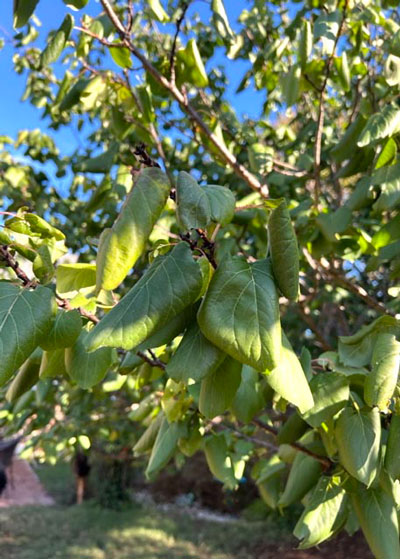

Answer: The wilted leaves show up quite well, but they’re just symptoms. The real problem is farther down the tree, probably right where you indicated. I don’t see the yellow fungus at the ground, but I do see very disturbed bark growth. It looks like there could be some kind of girdling going on, either from a surface root that is growing into the trunk or perhaps even a very small wire or piece or twine that is wrapped around the trunk. Something appears to cutting off normal growth and flow of water and nutrients up the trunk. Without cutting into the trunk, do a little close inspecting to see if you can determine any possible cause. Sadly, it may have gone too far to bring the tree back. For what it’s worth, apricots are very challenging in most of Texas. You have done much better than most folks do.
QUESTION 5
WILL HACKBERRY COMPOST RETARD GROWTH OF PLANTS?
Question: We have heard that hackberry tree leaves contain growth retardant. Can we use mulch made from well-rotted wood (cut down several years ago) and leaves in our garden? Will the retardant still be active? Pat K., Algoa, Galveston Co.
Answer: Use it all. The worries about oils, tannins, resins and other residues from trees are vastly over-anguished. While there may be some truth to it with nut-bearing trees like walnuts, pecans and even oaks, there are thousands of us who live in oak and pecan forests and who garden beneath the magnificent natives quite successfully. The secret with using any type of leaves or shredded wood as a soil amendment is that it must be well rotted before you put it into the soil. Otherwise it will tie up nitrogen and leave you with stunted plants. But your compost will be just fine.
QUESTION 6
WHAT IS WRONG WITH ROSES?
Question: Something is really wrong with all three of my rose bushes. The yellowing started after all that rain. It is progressively getting worse. I’m hoping the brown leaves are just older leaves. Would love to save these. Suggestions? Paula L., Carrollton.
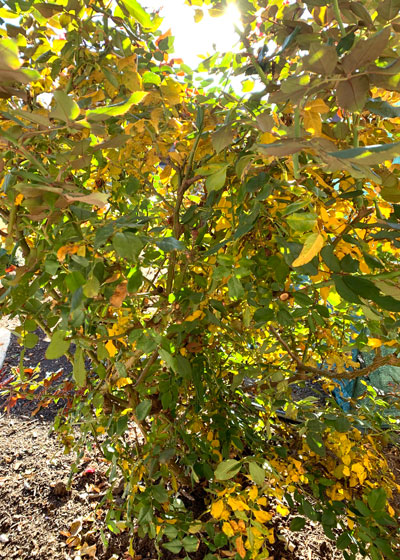
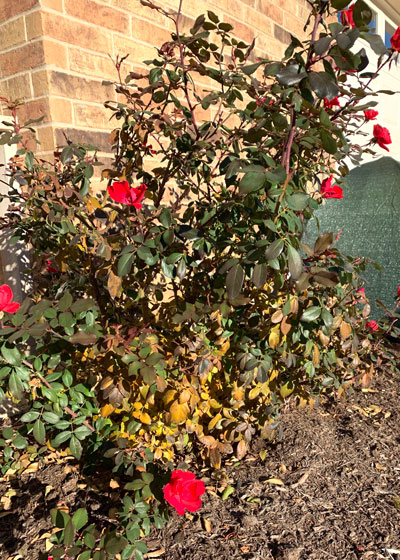
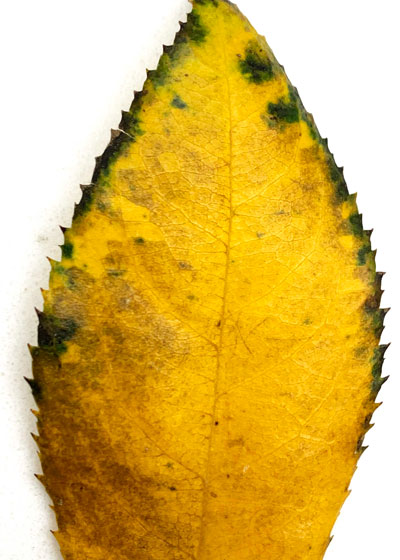
Answer: There probably is black spot fungus involved in the yellowing of leaves of your first photo. The browning of the lower leaves, as you suggested, is just old foliage that is shedding at the end of a brutal summer growing season. Fall rains helped generate some new growth, but the plant has still gotten rid of some of these old leaves just to lighten its load. And the third photo, the closeup of the yellow leaf, looks like a nutrient shortage. It’s too late to feed for this season, but starting in early March where you are you should apply a specialty rose food with minor elements included. I’m a bit confused as to why the plant in the one photo seems to be planted so close to the house. Roses need to be in raised beds 36 to 42 inches out from the house.
QUESTION 7
HOW CAN I CONTROL MOLES?
Question: Do you have a good way to rid our yard of moles? This is the first time we’ve had them in December. Barbie B., Stephenville.
Answer: Begging foregiveness, I’m just going to copy and paste my answer from the FAQ pages of my website. Hope this helps:
“Moles have hairless, pointed snouts extending nearly 1/2-inch in front of their mouth opening. Their small eyes and the opening of their ear canals are concealed in fur, and there are no external ears. Moles are insectivores, related to bats. Moles are generally found in cool, moist and shaded soils that are populated by earthworms and grub worms. Moles leave volcano-shaped hills that are often made up of clods of soil. Moles are best controlled using traps that are implanted into depressed portions of the surface tunnels. As the moles push up to re-open their tunnels, the traps are triggered.”
QUESTION 8
HOW CAN I GET RID OF WILD ONIONS?
Question: How can I get rid of these pesky wild onions? I have tried digging them up, but there must be an easier way. Richard R., Tarrant Co.
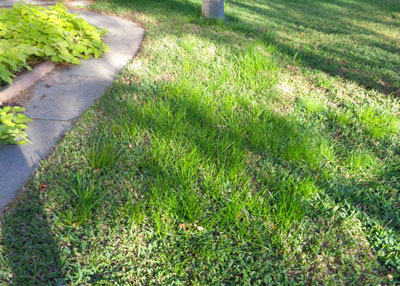
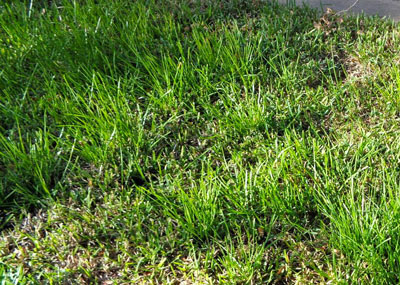
Answer: If you detect a distinct odor of onions when you’re pulling them, then use a broadleafed weedkiller spray containing 2,4-D. It probably will have two other herbicides mixed with it. You’ll get best results if you apply it with a pump sprayer and a small droplet size to coat the leaves. The more growth you have the better the control will be, so don’t mow for 5-7 days prior to spraying. It will take the herbicide a week or two to show good results. Read and follow label directions carefully. You may want to put one drop of liquid dishwashing detergent into each gallon of spray to help hold it onto the waxy leaves of the wild onions.
QUESTION 9
WHAT WILL CONTROL ROADSIDE HEATHER?
Question: I have roadside heather flowering and covering my St. Augustine lawn. Will pre-emergent granules prevent this problem, or do I have to dig it out? Selah H., Arlington.
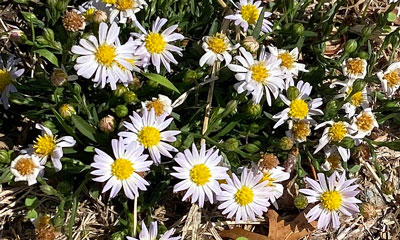
Answer: I’m going to guess that you’re referring to roadside aster. I’ve posted a photo of my own for identification to help. It is a weed that moves into lawns where it’s been difficult to get water and fertilizer (out back by the alley or out near the front walk, etc.). Usually, stepping up your lawn care will be the least expensive and most effective way to get rid of this weed, but you can also apply a broadleafed weedkiller spray (2,4-D) as the small seedlings are getting started in early summer. Pre-emergents would be much more expensive and would have to be applied in early March and repeated in early June.
